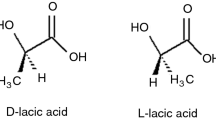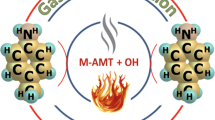Abstract
On the basis of pulse radiolysis experiments carried out with various polymers in dilute solution three modes of action of molecular oxygen, O2 can be discriminated with respect to main-chain scission: (a) O2 acts as a promoter, (b) O2 acts as an inhibitor, and (c) O2 acts as a fixing agent for main-chain breaks. The promoting mode of action (a) is due to the inhibition of simultaneously occurring intermolecular acrosslinking [DNA, poly(methyl vinyl ketone)] and/or to the combination of peroxyl radicals with the subsequent formation of readily decomposing oxyl radicals (polyethylene oxide, polyacrylamide, polyvinylpyrrolidone, polyribouridylic acid, polyriboadenylic acid, polyribocytidylic acid). The inhibiting mode of action (b) pertains to the reaction of O2 with macroradicals that otherwise undergo main-chain rupture [amylose, poly(methyl methacrylate)]. Fixing of main-chain ruptures (mode c) becomes important, if macroradicals generated by a very fast rupture of bonds in the main chain, are prone to recombine quickly. This mode of action was evidence in the case of polybutenesulfone, where main-chain scission involves the extrusion of small segments of the chain.
Similar content being viewed by others
References
W. SCHNABEL, Application of the Light Scattering Detection Method to Problems of Polymer Degradation, in Developments of Polymer Degradation. Vol. 2, N. GRASSIE (Ed.). Applied Science Publisher, London, 1979.
D. LINDENAU, S. W. BEAVAN, G. BECK, W. SCHNABEL, Europ. Polym. J., 13 (1977) 819.
K. WASHINO, W. SCHNABEL, Makromol. Chem., 183 (1982) 697.
T. COQUERELLE, U. HAGEN, in Effects of Ionizing Radiation on DNA, A. J. BERTINCHAMPS (Ed.), Springer, Berlin, 1978, p. 261 and references cited therein.
C. v. SONNTAG, D. SCHULTE-FROHLINDE, in Effects of Ionizing Radiation on DNA, by A. J. BERTINCHAMPS (Ed.), Springer, Berlin, 1978, p. 204 and references cited therein.
D. SCHULTE-FROHLINDE, E. BOTHE, Z. Naturforsch., 39c (1984) 315.
D. LINDENAU, U. HAGEN, W. SCHNABEL, Z. Naturforsch., 31c, (1976) 484. Radiat. Environ. Biophys., 13 (1976) 287.
U. GRÖLLMANN, W. SCHNABEL, Markomol. Chem., 181 (1980) 1215.
U. GRÖLLMANN, W. SCHNABEL, Polym. Degrad. Stabil., 4 (1982) 203.
U. GRÖLLMANN, W. SCHNABEL, unpublished results.
O. DENK, W. SCHNABEL, Z. Naturforsch., 37c. (1982) 405.
I. A. RAAP, U. GRÖLLMANN, Makromol. Chem., 184 (1983) 123.
G. BECK, D. LINDENAU, W. SCHNABEL, Maromolecules, 10 (1977) 135.
U. GRÖLLMANN, W. SCHNABEL, unpublished results.
K. HORIE, W. SCHNABEL, Polym. Degrad. Stab., 8 (1984) 145.
Author information
Authors and Affiliations
Rights and permissions
About this article
Cite this article
Schnabel, W. Oxidative degradation processes in synthetic and biological polymers as studied by pulse radiolysis experiments. Journal of Radioanalytical and Nuclear Chemistry, Articles 101, 413–432 (1986). https://doi.org/10.1007/BF02042443
Received:
Issue Date:
DOI: https://doi.org/10.1007/BF02042443




